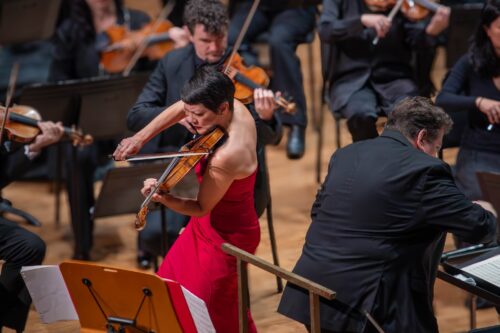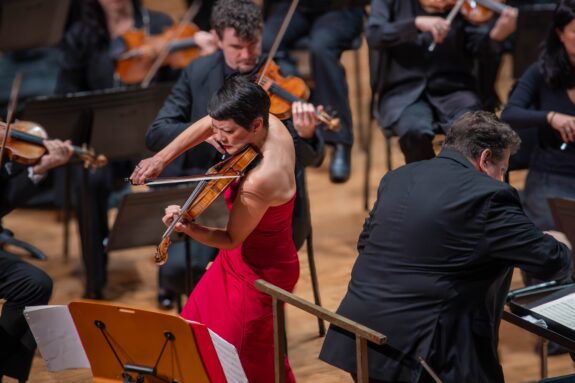 Canada Márquez, Stravinsky, Ravel: Anne Akiko Meyers (violin), Vancouver Symphony Orchestra / Andrew Litton (conductor). Orpheum Theatre, Vancouver, 18.10.2024. (GN)
Canada Márquez, Stravinsky, Ravel: Anne Akiko Meyers (violin), Vancouver Symphony Orchestra / Andrew Litton (conductor). Orpheum Theatre, Vancouver, 18.10.2024. (GN)

Márquez – Fandango
Stravinsky – Divertimento from Le baiser de la fée
Ravel – Valses nobles et sentimentales; La valse
This was a very entertaining ‘dance’ concert with Andrew Litton, currently conductor of the New York City Ballet. Given the Vancouver Symphony’s recent interest in presenting brilliant, effect-laden pieces that can resonate strongly with a younger audience, the showstopper here was the Canadian premiere of Mexican composer Arturo Márquez’s Fandango, commissioned and played by long-standing virtuoso violinist Anne Akiko Meyers. Though somewhat anachronistic and rudimentary in construction for a work of the current era, it really packs a wallop when played with the flare and emotional commitment displayed by Meyers and Litton. The rhythms of Ravel’s Valses nobles et sentimentales and La valse, coupled with Stravinsky’s balletic Divertimento from Le baiser de la fée, provided an attractive complement.
For all intents and purposes, Fandango is a traditional three-movement violin concerto, but one that aims to convey the intensity and passion of Spanish and Mexican dances which flourished on the ballroom dance floors of yesteryear. For the listener, the seductive rhythms might transport one directly to the dance floor in a Latino club. On the other hand, the work’s brightly-lit luxuriance, élan and smouldering emotions might take one in the direction of the Khachaturian Violin Concerto, both in its strengths and in its weaknesses, although fragrances of Rodrigo, de Falla and Lalo’s Symphonie espagnole can be found in the orchestral colours of the slow movement.
The work is no constructional wonder. In both opening and closing movements, the writing for the violin is basic and almost generic, featuring musical motives modulating up the scale note by note, then back down again, broken by strong sforzandos and varied arpeggiation and pyrotechnics. For all its virtuoso sheen, there is considerable repetition and little feeling of introspective repose, and at times the soloist and the orchestra imitate each other’s lines too closely. Nonetheless, the work invites a strong and passionate response, and any performer must simply ride over its inadequacies and play it for all it is worth.
That is certainly what Anne Akiko Meyers and Andrew Litton did on this occasion. The violinist always pushed forward with strength and feeling as if her life depended on it, while the conductor kept the orchestra tightly together, bringing life-enhancing emotional weight to the surging dance tunes. The slow movement brought more repose and introduced darker orchestral colours, though it was the sensuality of the feeling, not its depth, that dominated. ‘Pianissimo’ does not figure much in the composer’s vocabulary.
As played here, the work can definitely be a ‘spectacle’ of sorts and has some of the same emotional grip as the ‘Danzon No.2’ which initially made Márquez famous. Both have been championed by Gustavo Dudamel and the LA Philharmonic. Overall, I enjoyed this adventure, as did the audience. This work has plenty of colour, and the seeming joy of the violinist and the orchestra in making the piece communicate was contagious. Nonetheless, I would still regard Fandango as more of a pop-classical composition, and I would not place it among the more distinguished Latin-American violin concertos such as those of Rodrigo and Ginastera. It offers ample red wine but is light on dinner.
Andrew Litton brought an almost symphonic strength and shaping to the other dance pieces. Stravinsky’s Divertimento from Le baiser de la fée was written as a tribute to Tchaikovsky, and Litton often mined sweet, lush textures to make the tribute clear. For me, the reading was slightly more upholstered than I am used to, with less adventurous woodwinds and less fairy tale caprice, but it was good to hear a more romantic take. Ravel’s Valses nobles et sentimentales was given a performance of cumulative strength, playing up the power of the dance rhythms but playing down some of their joyful enthusiasm. The result was cogent and interesting but slightly light on fantasy and French charm. The closing La valse was very powerful indeed and built to an earth-shaking climax.
A lighter concert, but a most enjoyable and entertaining one.
Geoffrey Newman
